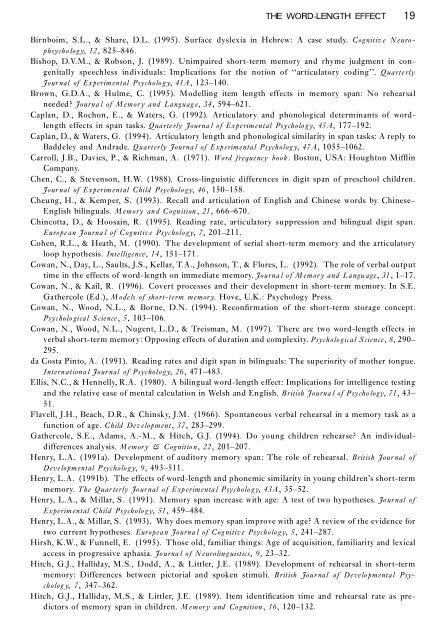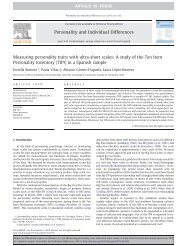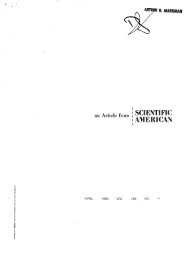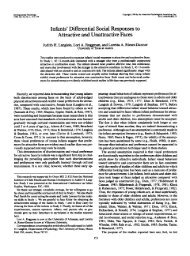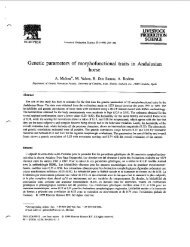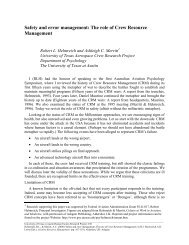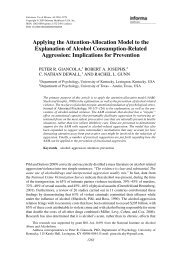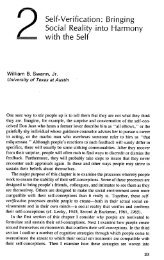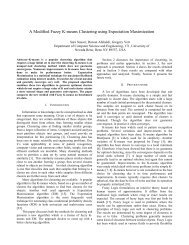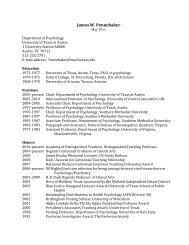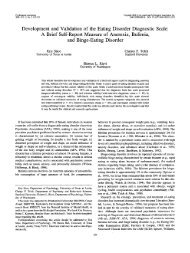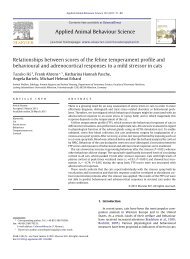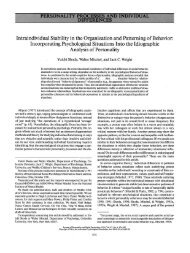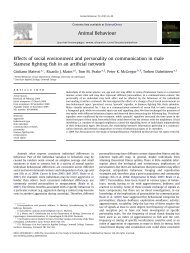The Word-Length Effect and Disyllabic Words (Lovatt
The Word-Length Effect and Disyllabic Words (Lovatt
The Word-Length Effect and Disyllabic Words (Lovatt
You also want an ePaper? Increase the reach of your titles
YUMPU automatically turns print PDFs into web optimized ePapers that Google loves.
THE WORD-LENGTH EFFECT 19<br />
Birnboim, S.L., & Share, D.L. (1995). Surface dyslexia in Hebrew: A case study. Cognitiv e N europhsycho<br />
logy, 12, 825±846.<br />
Bishop, D.V.M., & Robson, J. (1989). Unimpaired short-term memory <strong>and</strong> rhyme judgment in congenitally<br />
speechless individuals: Implications for the notion of ``articulatory coding’’. Q uarte rly<br />
Jour nal of Experim ental Psychology, 41A , 123±140.<br />
Brown, G.D.A., & Hulme, C. (1995). Modelling item length effects in memory span: No rehearsal<br />
needed? Journa l of M emory <strong>and</strong> Languag e, 34, 594±621.<br />
Caplan, D., Rochon, E., & Waters, G. (1992). Articulatory <strong>and</strong> phonological determinants of wordlength<br />
effects in span tasks. Quarte rly Journa l of Experim ental Psychology, 45 A, 177±192.<br />
Caplan, D., & Waters, G. (1994). Articulatory length <strong>and</strong> phonological similarity in span tasks: A reply to<br />
Baddeley <strong>and</strong> Andrade. Quarterly Journa l of E xperimental Psychology, 47 A, 1055±1062.<br />
Carroll, J.B., Davies, P., & Richman, A. (1971). <strong>Word</strong> frequency book. Boston, USA: Houghton Mif¯in<br />
Company.<br />
Chen, C., & Stevenson, H.W. (1988). Cross-linguistic differences in digit span of preschool children.<br />
Jour nal of Experim ental Child Psychology, 46, 150±158.<br />
Cheung, H., & Kemper, S. (1993). Recall <strong>and</strong> articulation of English <strong>and</strong> Chinese words by Chinese±<br />
English bilinguals. M emory an d C ognition, 21, 666±670.<br />
Chincotta, D., & Hoosain, R. (1995). Reading rate, articulatory suppression <strong>and</strong> bilingual digit span.<br />
Europe an Journa l of Cognitive Psychology, 7, 201±211.<br />
Cohen, R.L., & Heath, M. (1990). <strong>The</strong> development of serial short-term memory <strong>and</strong> the articulatory<br />
loop hypothesis. Intelligence, 14, 151±171.<br />
Cowan, N., Day, L., Saults, J.S., Kellar, T.A., Johnson, T., & Flores, L. (1992). <strong>The</strong> role of verbal output<br />
time in the effects of word-length on immediate memory. Journa l of M emory <strong>and</strong> Langu age, 31, 1±17.<br />
Cowan, N., & Kail, R. (1996). Covert processes <strong>and</strong> their development in short-term memory. In S.E.<br />
Gathercole (Ed.), M odels of short-term memory. Hove, U.K.: Psychology Press.<br />
Cowan, N., Wood, N.L., & Borne, D.N. (1994). Recon®rmation of the short-term storage concept.<br />
Psychological Science, 5, 103±106.<br />
Cowan, N., Wood, N.L., Nugent, L.D., & Treisman, M. (1997). <strong>The</strong>re are two word-length effects in<br />
verbal short-term memory: Opposing effects of duration <strong>and</strong> complexity. Psychological Science, 8, 290±<br />
295.<br />
da Costa Pinto, A. (1991). Reading rates <strong>and</strong> digit span in bilinguals: <strong>The</strong> superiority of mother tongue.<br />
Internationa l Jour nal of Psychology, 26, 471±483.<br />
Ellis, N.C., & Hennelly, R.A. (1980). A bilingual word-length effect: Implications for intelligence testing<br />
<strong>and</strong> the relative ease of mental calculation in Welsh <strong>and</strong> English. British Journa l of Psycho logy, 71, 43±<br />
51.<br />
Flavell, J.H., Beach, D.R., & Chinsky, J.M. (1966). Spontaneous verbal rehearsal in a memory task as a<br />
function of age. Child Development, 37, 283±299.<br />
Gathercole, S.E., Adams, A.-M., & Hitch, G.J. (1994). Do young children rehearse? An individualdifferences<br />
analysis. M emory & Cognition, 22, 201±207.<br />
Henry, L.A. (1991a). Development of auditory memory span: <strong>The</strong> role of rehearsal. British Jour nal of<br />
Developm ental Psychology, 9, 493±511.<br />
Henry, L.A. (1991b). <strong>The</strong> effects of word-length <strong>and</strong> phonemic similarity in young children’s short-term<br />
memory. <strong>The</strong> Quar terly Journal of Experimental Psychology, 43A , 35±52.<br />
Henry, L.A., & Millar, S. (1991). Memory span increase with age: A test of two hypotheses. Journal of<br />
Experim ental Child Psychology, 51, 459±484.<br />
Henry, L.A., & Millar, S. (1993). Why does memory span improve with age? A review of the evidence for<br />
two current hypotheses. European Journa l of Cognitiv e Psychology, 5, 241±287.<br />
Hirsh, K.W., & Funnell, E. (1995). Those old, familiar things: Age of acquisition, familiarity <strong>and</strong> lexical<br />
access in progressive aphasia. Journa l of N eurolinguistics, 9, 23±32.<br />
Hitch, G.J., Halliday, M.S., Dodd, A., & Littler, J.E. (1989). Development of rehearsal in short-term<br />
memory: Differences between pictorial <strong>and</strong> spoken stimuli. British Jour nal of Developmental Psycholog<br />
y, 7, 347±362.<br />
Hitch, G.J., Halliday, M.S., & Littler, J.E. (1989). Item identi®cation time <strong>and</strong> rehearsal rate as predictors<br />
of memory span in children. M emory <strong>and</strong> Cognition, 16, 120±132.


